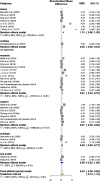Microplastic Contamination of Seafood Intended for Human Consumption: A Systematic Review and Meta-Analysis
- PMID: 33355482
- PMCID: PMC7757379
- DOI: 10.1289/EHP7171
Microplastic Contamination of Seafood Intended for Human Consumption: A Systematic Review and Meta-Analysis
Abstract
Background: Microplastics (MPs) have contaminated all compartments of the marine environment including biota such as seafood; ingestion from such sources is one of the two major uptake routes identified for human exposure.
Objectives: The objectives were to conduct a systematic review and meta-analysis of the levels of MP contamination in seafood and to subsequently estimate the annual human uptake.
Methods: MEDLINE, EMBASE, and Web of Science were searched from launch (1947, 1974, and 1900, respectively) up to October 2020 for all studies reporting MP content in seafood species. Mean, standard deviations, and ranges of MPs found were collated. Studies were appraised systematically using a bespoke risk of bias (RoB) assessment tool.
Results: Fifty studies were included in the systematic review and 19 in the meta-analysis. Evidence was available on four phyla: mollusks, crustaceans, fish, and echinodermata. The majority of studies identified MP contamination in seafood and reported MP content , with 26% of studies rated as having a high RoB, mainly due to analysis or reporting weaknesses. Mollusks collected off the coasts of Asia were the most heavily contaminated, coinciding with reported trends of MP contamination in the sea. According to the statistical summary, MP content was in mollusks, in crustaceans, in fish, and in echinodermata. Maximum annual human MP uptake was estimated to be close to 55,000 MP particles. Statistical, sample, and methodological heterogeneity was high.
Discussion: This is the first systematic review, to our knowledge, to assess and quantify MP contamination of seafood and human uptake from its consumption, suggesting that action must be considered in order to reduce human exposure via such consumption. Further high-quality research using standardized methods is needed to cement the scientific evidence on MP contamination and human exposures. https://doi.org/10.1289/EHP7171.
Figures








Comment in
-
Microplastics in Seafood: How Much Are People Eating?Environ Health Perspect. 2021 Mar;129(3):34001. doi: 10.1289/EHP8936. Epub 2021 Mar 17. Environ Health Perspect. 2021. PMID: 33730867 Free PMC article.
References
Publication types
MeSH terms
Substances
LinkOut - more resources
Full Text Sources
Other Literature Sources
Medical
Miscellaneous

